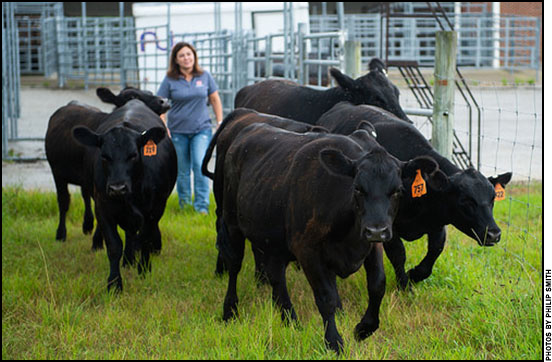MARKETING...

Research to Ensure
Safety of Local Foods Movement
The local foods movement is expanding across the country, but the question of food safety could be an obstacle to further growth.
The local foods movement continues to grow in the United States, with an increasing number of consumers wanting to know where their food comes from and buying it at farmers’ markets and through community-supported agriculture programs. It’s a social, face-to-face process that creates a connection with the families producing it.
One of the obstacles to further growth, however, is ensuring locally produced foods are produced and distributed safely.
Working with a more-than-$4 million grant from the USDA National Institute of Food and Agriculture, Auburn University researchers are addressing the gaps between knowledge and practice in the production and distribution of local and regional foods, with the ultimate goal of ensuring a more secure food chain. Read more.
In the Cattle Markets
Cattle vs. beef cycles.
The latest USDA Cattle report provided the most recent pieces of information to the ever-evolving picture of the cattle inventory. The big news was the number of heifers held for replacement declined year over year, and the 2018 calf crop is estimated to be about 2% larger than 2017. The calf crop number tells a story of continued larger beef production for 2019, while the lower heifer retention rate suggests herd growth is slowing. Combine the retention rate with cow and heifer slaughter data and they collectively point to a significantly slowing herd growth rate. Read more.
Trade Turbulence and Global Ag Markets
Major players in ag commodity trade identified.
Ag markets are caught in a whirlwind of trade disruptions. Direct market shocks will lead to ripple effects likely to affect most ag markets worldwide in the coming months. It’s important to have a global perspective of major ag markets in order to anticipate how markets may be affected. The following global market profiles are based on current USDA estimates. Read more.
Beef Blockchain to Provide Transparency
Blockchain technology will provide beef market with greater visibility, safety and efficiency.
Kelly Products announced that the company has started a blockchain system for tracking proteins in the Southeastern United States. The new blockchain system will address current issues producers face with building a traceable brand for beef and other proteins. Read more.

Ginette Gottswiller
The Source
My calving survival list just got easier with the Angus Black Book mobile app.
The first calf hit the ground yesterday. I know many people think we are crazy calving in mid-August, but it really helps to get 30 days’ worth of calves on the ground before it’s time to start the combine rolling. I need to get the tags, tag pens, taggers and all the other calving equipment found and restocked. More important will be the different calving books we used to do calf checks and my nightly job of putting everyone’s entries into each book.
This year I will be excited to test-drive the soon-to-be released Angus Black Book mobile app for commercial cattle producers. This app may be handier than soles on your boots. Read more.
Tremendous First Half for U.S Beef Exports
Beef muscle cut exports are setting a new record high.
Strong June results capped a huge first half of 2018 for U.S. beef exports, according to data released by USDA and compiled by the U.S. Meat Export Federation (USMEF). June pork exports were lower than a year ago for the second consecutive month, but first-half volume and value remained ahead of last year’s pace. Read more.
Opportunities in China
Update on beef consumption and growing beef imports in China.
Total beef consumption in China in 2018 is estimated at 8.5 million metric tons, second only to beef consumption in the United States, according to the USDA Foreign Agricultural Service. On a per capita basis, this is about 9.4 pounds (lb.) on a retail basis per person. This level is 16% of projected 2018 U.S. retail beef consumption of 57.7 lb. per capita.
In China, beef consumption is about 11% of total meat consumption, ranking behind poultry (15%) and pork, which is hugely popular and represents 74% of meat consumption. These values do not include fish and seafood, which are very popular in China. Read more.






